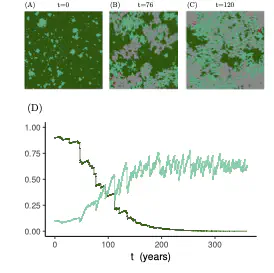Dynamics of Invasion in Forest-Fire Models

Abstract
Fire disturbances can trigger biological invasions and reshape landscapes. We develop a spatial stochastic model to analyze the invasion dynamics of fire-adapted species into regions with historically low fire occurrence. The model incorporates two key parameters that characterize positive feedback with fire: post-fire vegetation regrowth and fire spread rates. After fire events, rapid vegetation regrowth facilitates the expansion of invasive species, which in turn increases both fire frequency and intensity. Our results reveal a continuous transition toward native species extinction as fire disturbance becomes the dominant factor in system dynamics. The system shows the highest sensitivity to external fluctuations during this transition phase. Spatial heterogeneity significantly influences the dynamics: notably, native species face higher extinction risk when invasive species are concentrated in a single cluster compared to random spatial distribution. These findings emphasize how spatial patterns of invasion, combined with fire-vegetation feedback, can accelerate native species decline.